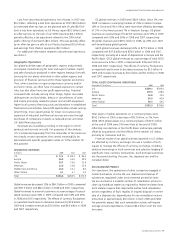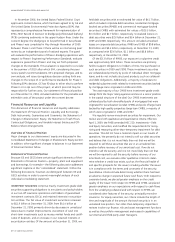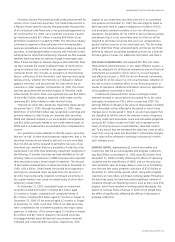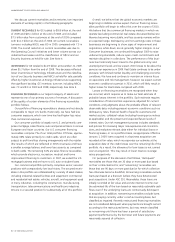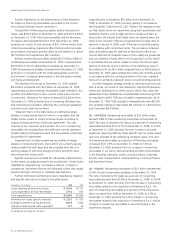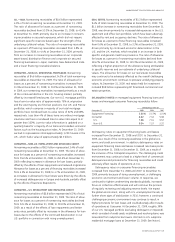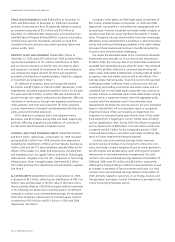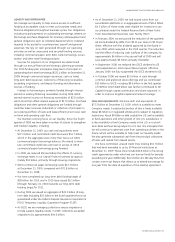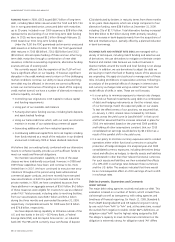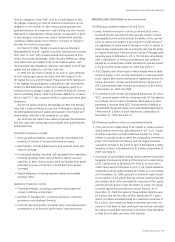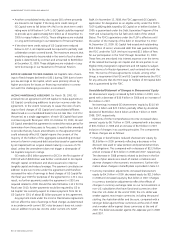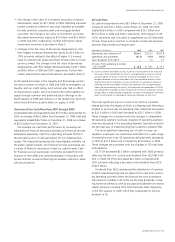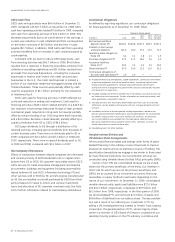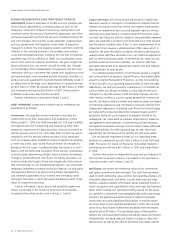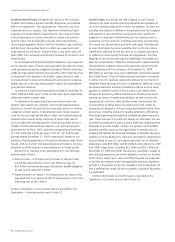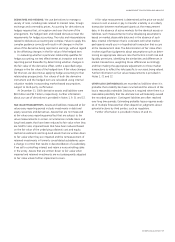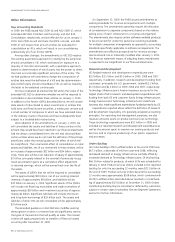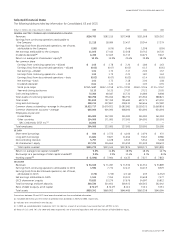GE 2009 Annual Report Download - page 51
Download and view the complete annual report
Please find page 51 of the 2009 GE annual report below. You can navigate through the pages in the report by either clicking on the pages listed below, or by using the keyword search tool below to find specific information within the annual report.’
GE 2009 ANNUAL REPORT 49
from an obligation rated “AAA” only to a small degree in that
the obligor’s capacity to meet its financial commitment on the
obligation is very strong. An S&P rating outlook assesses the
potential direction of a long-term credit rating over the interme-
diate term. In determining a rating outlook, consideration is given
to any changes in the economic and/or fundamental business
conditions. Stable means that a rating is not likely to change in
the next six months to two years.
On March 23, 2009, Moody’s Investors Service (Moody’s)
downgraded GE and GE Capital’s long-term rating by two notches
from “Aaa” to “Aa2” with a stable outlook and removed us from
review for possible downgrade. Under Moody’s definitions, obliga-
tions rated “Aaa” are judged to be of the highest quality, with
minimal credit risk. Obligations rated “Aa” are judged to be of high
quality and are subject to very low credit risk.
In 2009, the short-term ratings of “A–1+/P–1” were affirmed
by both rating agencies at the same time with respect to GE,
GE Capital Services and GE Capital. These short-term ratings are
in the highest rating categories available from S&P and Moody’s.
Under the S&P definitions, a short-term obligation rated “A–1+”
indicates that the obligor’s capacity to meet its financial commit-
ment is extremely strong. Under the Moody’s definitions, an issuer
that is rated “P–1” has a superior ability to repay short-term debt
obligations.
We do not believe that the downgrades by S&P and Moody’s
have had a material impact on our cost of funding or liquidity as
the downgrades had been widely anticipated in the market and
were already reflected in the spreads on our debt.
GE, GECS and GE Capital have distinct business characteristics
that the major debt rating agencies evaluate both quantitatively
and qualitatively.
Quantitative measures include:
• Earnings and profitability, revenue growth, the breadth and
diversity of sources of income and return on assets
• Asset quality, including delinquency and write-off ratios and
reserve coverage
• Funding and liquidity, including cash generated from operating
activities, leverage ratios such as debt-to-capital, retained
cash flow to debt, market access, back-up liquidity from banks
and other sources, composition of total debt and interest
coverage
• Capital adequacy, including required capital and tangible
leverage ratios
Qualitative measures include:
• Franchise strength, including competitive advantage and
market conditions and position
• Strength of management, including experience, corporate
governance and strategic thinking
• Financial reporting quality, including clarity, completeness and
transparency of all financial performance communications
PRINCIPAL DEBT CONDITIONS are described below.
The following conditions relate to GE and GECS:
• Swap, forward and option contracts are executed under
standard master agreements that typically contain mutual
downgrade provisions that provide the ability of the counter-
party to require termination if the long-term credit rating of
the applicable GE entity were to fall below A–/A3. In certain of
these master agreements, the counterparty also has the ability
to require termination if the short-term rating of the applicable
GE entity were to fall below A–1/P–1. The net derivative liability
after consideration of netting arrangements and collateral
posted by us under these master agreements was estimated
to be $1.3 billion at December 31, 2009. See Note 22.
• If GE Capital’s ratio of earnings to fixed charges were to dete-
riorate to below 1.10:1, GE has committed to make payments
to GE Capital. See Income Maintenance Agreement section for
further discussion. GE also guaranteed certain issuances of
GECS subordinated debt having a face amount of $0.4 billion
at December 31, 2009 and 2008.
• In connection with certain subordinated debentures for which
GECC receives equity credit by rating agencies, GE has agreed
to promptly return to GECC dividends, distributions or other
payments it receives from GECC during events of default or
interest deferral periods under such subordinated debentures.
There were $7.6 billion of such debentures outstanding at
December 31, 2009. See Note 10.
The following conditions relate to consolidated entities:
• If the short-term credit rating of GE Capital or certain consoli-
dated entities were to be reduced below A–1/P–1, GE Capital
would be required to provide substitute liquidity for those
entities or provide funds to retire the outstanding commercial
paper. The maximum net amount that GE Capital would be
required to provide in the event of such a downgrade is deter-
mined by contract, and amounted to $2.5 billion at December 31,
2009. See Note 23.
• One group of consolidated entities holds investment securities
funded by the issuance of GICs. If the long-term credit rating
of GE Capital were to fall below AA–/Aa3 or its short-term
credit rating were to fall below A–1+/P–1, GE Capital would be
required to provide approximately $2.4 billion to such entities
as of December 31, 2009, pursuant to letters of credit issued
by GE Capital. To the extent that the entities’ liabilities exceed
the ultimate value of the proceeds from the sale of their assets
and the amount drawn under the letters of credit, GE Capital
could be required to provide such excess amount. As of
December 31, 2009, the value of these entities’ liabilities was
$8.5 billion and the fair value of their assets was $7.3 billion
(which included unrealized losses on investment securities of
$1.4 billion). With respect to these investment securities, we
intend to hold them at least until such time as their individual
fair values exceed their amortized cost and we have the ability
to hold all such debt securities until maturity.


